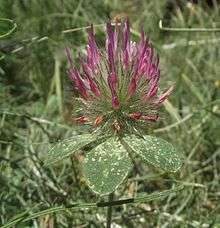Trifolium hirtum
Trifolium hirtum is a species of clover known by the common name rose clover.[1][2] It is native to Europe, Western Asia, and North Africa. It is present elsewhere as an introduced species and it is cultivated as a cover crop and animal fodder. It was introduced to California from Turkey in the 1940s as a forage crop, and today it is a widespread roadside weed there.[3][4]
| Trifolium hirtum | |
|---|---|
 | |
| Scientific classification | |
| Kingdom: | Plantae |
| Clade: | Tracheophytes |
| Clade: | Angiosperms |
| Clade: | Eudicots |
| Clade: | Rosids |
| Order: | Fabales |
| Family: | Fabaceae |
| Genus: | Trifolium |
| Species: | T. hirtum |
| Binomial name | |
| Trifolium hirtum | |
It is a hairy annual herb growing erect in form. The leaves have oval leaflets up to 2.5 centimeters long and bristle-tipped stipules. The inflorescence is a head of flowers about 1.5 centimeters wide. Each flower has a calyx of sepals with long, needlelike lobes that may harden into bristles with age. The calyces are coated in long hairs. The flower has a pink corolla 1 or 1.5 centimeters long.
References
- "Trifolium hirtum". Natural Resources Conservation Service PLANTS Database. USDA. Retrieved 15 December 2015.
- "BSBI List 2007". Botanical Society of Britain and Ireland. Archived from the original (xls) on 2015-01-25. Retrieved 2014-10-17.
- Jain, S. K. and P. S. Martins. (1979). Ecological genetics of the colonizing ability of rose clover (Trifolium hirtum All.) American Journal of Botany 66:4 361-66.
- Molina-Freaner, F. and S. K. Jain. (1992). Inheritance of male sterility in Trifolium hirtum All. Genetica 85:2 153-61,
External links
![]()
- Jepson Manual Treatment
- "Trifolium hirtum". Germplasm Resources Information Network (GRIN). Agricultural Research Service (ARS), United States Department of Agriculture (USDA).
- Photo gallery